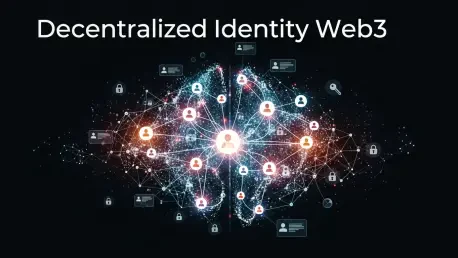Imagine a digital landscape where individuals hold the reins of their personal data, deciding precisely what to share and with whom, all while navigating a decentralized internet powered by blockchain technology. This vision is becoming a reality through Decentralized Identity (DeID), a transformative concept at the heart of Web3—the next generation of the web focused on user empowerment and decentralization. Unlike traditional systems where tech giants or governments control identity data, DeID enables self-sovereign control through cryptographic tools, allowing users to protect their privacy in an era of rampant data exploitation. By 2025, DeID is no longer just an idea but a practical solution gaining momentum across industries. It addresses critical issues like safeguarding personal information and meeting regulatory demands for blockchain-based institutions. This shift promises to redefine online interactions, making them more secure and user-centric in the evolving Web3 ecosystem.
Redefining Privacy in a Data-Driven Era
The surge of data breaches and the commodification of personal information by centralized entities have made privacy a pressing concern in the digital age. Decentralized Identity offers a groundbreaking response by placing control back into users’ hands through self-sovereign identity (SSI) principles. With DeID, individuals can share only the specific data needed for a transaction or service, using blockchain-based credentials to ensure security. Gone are the days of blanket consent agreements that expose entire personal profiles just to access an app or platform. By 2025, this paradigm shift is empowering users to maintain anonymity when desired while still establishing trust through verifiable, tamper-proof credentials. The impact on Web3 is profound, as it fosters a digital environment where privacy isn’t just an afterthought but a fundamental right baked into the system.
Beyond individual empowerment, DeID’s privacy focus challenges the very structure of how data is handled online. Traditional models often store vast amounts of sensitive information in centralized databases, creating prime targets for cyberattacks. DeID disrupts this by minimizing data exposure—only essential attributes are shared, and even then, often through cryptographic methods that obscure underlying details. By 2025, this approach is proving instrumental in Web3 ecosystems, where trust must be established without relying on vulnerable central authorities. The reduction in data footprints not only protects users but also alleviates the burden on service providers to secure massive datasets. As privacy concerns continue to drive public discourse, DeID stands as a beacon of change, aligning with societal demands for greater control over personal information in a hyper-connected world.
Enabling Regulatory Compliance for Web3 Adoption
A significant barrier to Web3’s widespread acceptance by traditional institutions has been the challenge of regulatory compliance, particularly with standards like Know Your Customer (KYC) and Anti-Money Laundering (AML). Decentralized Identity addresses this head-on by introducing Decentralized Identifiers (DIDs) and Verifiable Credentials (VCs), which allow for privacy-preserving verification of user attributes such as age or residency. These tools enable institutions to meet legal requirements without storing sensitive personal data, thereby reducing risk and enhancing security. By 2025, DeID is becoming a linchpin for bridging the gap between decentralized technologies and regulatory frameworks, offering immutable blockchain records for auditability and reusable credentials that streamline user experiences across global platforms.
The benefits of DeID for compliance extend beyond mere adherence to rules—they reshape how institutions engage with Web3. By minimizing the data they handle, service providers face fewer liabilities related to breaches or misuse, while users enjoy a frictionless process of credential verification that works across borders. This global interoperability is critical in 2025, as businesses increasingly operate in a borderless digital economy. The ability to confirm necessary information without compromising privacy aligns perfectly with the ethos of Web3, fostering trust among stakeholders who might otherwise hesitate to adopt blockchain solutions. As regulatory bodies continue to scrutinize decentralized systems, DeID provides a pathway to integrate compliance seamlessly, ensuring that innovation doesn’t come at the expense of accountability or legal standards.
Technological Innovations Fueling DeID’s Rise
The practical implementation of Decentralized Identity hinges on a suite of technological advancements that have matured significantly by 2025. Blockchain networks designed specifically for identity management form the backbone of DeID systems, providing a secure and transparent foundation for storing and verifying credentials. Innovations like zero-knowledge proofs (ZKPs) are pivotal, enabling the confirmation of data attributes without revealing the data itself, thus preserving user privacy. Additionally, open standards set by organizations like the World Wide Web Consortium (W3C) ensure that DIDs and VCs are interoperable across diverse ecosystems. These developments collectively make DeID not just viable but increasingly user-friendly for widespread adoption in Web3 environments.
Further bolstering DeID’s potential are complementary technologies that enhance scalability and accessibility. Layer 2 solutions address transaction speed and cost issues on blockchain networks, making identity verification more efficient for large-scale use. Integration into popular Web3 wallets simplifies the user experience, while cross-chain compatibility protocols ensure credentials function across different blockchain platforms. By 2025, these advancements are removing technical barriers that once hindered DeID’s rollout, paving the way for seamless integration into everyday digital interactions. The convergence of robust infrastructure and privacy-focused tools underscores DeID’s role as a cornerstone of Web3, promising a future where identity management is both secure and universally accessible without reliance on centralized gatekeepers.
Expanding Horizons: DeID’s Diverse Applications
While privacy and compliance are core drivers, the influence of Decentralized Identity extends into a variety of transformative applications by 2025. Envision secure digital voting systems where voter identities are verified without compromising anonymity, or academic and professional credentials that are instantly verifiable across institutions worldwide. Even in the metaverse, DeID enables persistent digital avatars tied to verifiable identities, enhancing user experiences while protecting personal data. The capacity to manage reputation and access rights across multiple platforms without exposing unnecessary information is redefining how trust is built in virtual spaces, positioning DeID as a versatile tool for the future of digital engagement within Web3.
The broader implications of these applications signal a shift in how society interacts with technology. Governments and enterprises are beginning to recognize the efficiency and security benefits of DeID, integrating it into systems that range from public services to private sector innovations. By 2025, this trend is accelerating as the digital economy demands solutions that prioritize user autonomy alongside operational needs. The ability to carry a single, secure identity across diverse contexts—whether casting a vote, proving qualifications, or navigating virtual worlds—reduces friction and enhances trust in decentralized systems. As these use cases proliferate, DeID is emerging as more than a technical solution; it’s becoming a fundamental building block for a reimagined internet where individuals and organizations alike can operate with confidence.
Emerging Trends Supporting DeID in Web3
A powerful consensus is forming around Decentralized Identity as an indispensable element of Web3’s growth in 2025. The escalating demand for privacy, driven by widespread distrust of centralized data control, aligns seamlessly with DeID’s user-centric approach, empowering individuals to dictate the terms of their digital presence. Simultaneously, the emphasis on interoperability and standardization—ensuring credentials are recognized universally—mirrors Web3’s vision of a cohesive, borderless digital realm. The integration of advanced cryptographic tools like ZKPs reflects a shared commitment to balancing privacy with practical functionality, addressing concerns about misuse while safeguarding user data in an increasingly complex online landscape.
Another notable trend is the growing recognition of DeID as a trust-building mechanism across stakeholders. By resolving longstanding pain points such as data vulnerability and regulatory uncertainty, DeID fosters confidence among users, businesses, and policymakers engaging with Web3 technologies. In 2025, this trust is proving essential as blockchain adoption expands into mainstream sectors, necessitating solutions that align innovation with accountability. The convergence of societal needs and technological maturity positions DeID as a timely answer to the challenges of a data-driven world, signaling a shift toward a more secure and equitable internet where user sovereignty is paramount, supported by systems designed for global collaboration.
Overcoming Obstacles in DeID’s Journey
Despite the optimism surrounding Decentralized Identity, several challenges remain that could temper its impact on Web3 in 2025. The complexity of decentralized systems poses a steep learning curve for both users and organizations, potentially slowing adoption rates. Many may find the transition from familiar centralized models to self-sovereign identity daunting, highlighting the need for intuitive interfaces and comprehensive education. Additionally, fragmented DeID frameworks risk undermining the goal of interoperability, as disparate standards could create silos rather than a unified ecosystem. These hurdles underscore the importance of collaborative efforts to simplify and standardize DeID solutions for broader accessibility.
Security concerns and resistance from traditional identity providers also loom as significant barriers. The potential for new forms of digital identity misuse demands robust system design to prevent exploitation, while established centralized entities may push back against losing control over data management. In 2025, addressing these issues requires ongoing innovation to fortify DeID systems against threats and strategic dialogue to ease tensions with legacy providers. Despite these obstacles, the overarching belief holds that the advantages of DeID—enhanced privacy, reduced data risks, and regulatory alignment—far outweigh the drawbacks. With dedicated efforts to educate and innovate, these challenges can be navigated, ensuring DeID solidifies its transformative role in shaping a more secure Web3 future.
Reflecting on DeID’s Transformative Path
Looking back, the journey of Decentralized Identity by 2025 reveals a remarkable evolution from a promising concept to a tangible force within Web3. It has tackled critical issues like user privacy and regulatory compliance with innovative tools such as Decentralized Identifiers and Verifiable Credentials, empowering individuals and institutions alike. The technological strides, from blockchain advancements to zero-knowledge proofs, have supported a robust framework that redefined digital trust. As DeID integrated into diverse applications like voting and metaverse interactions, it reshaped the landscape of online engagement. Moving forward, stakeholders must focus on simplifying user experiences and standardizing systems to overcome adoption barriers. Collaborative efforts between technologists, regulators, and educators will be essential to sustain this momentum, ensuring that DeID continues to build a decentralized internet grounded in security and user autonomy for years to come.









